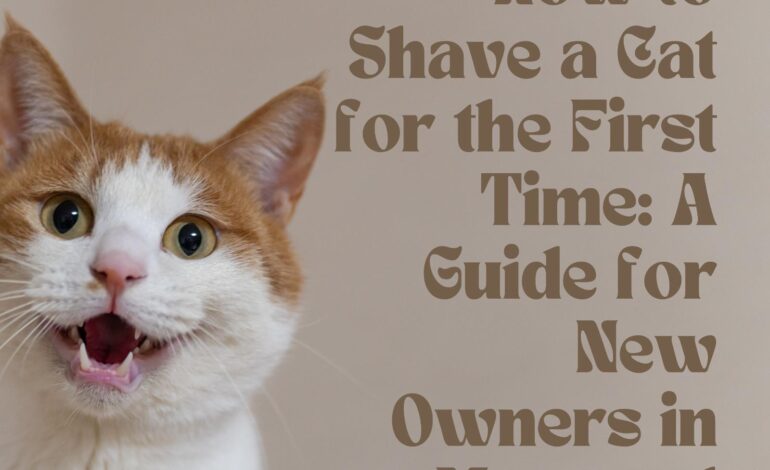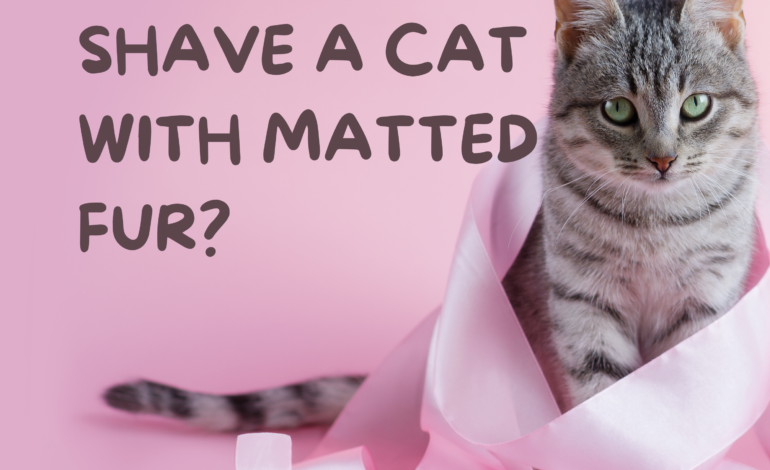How to Shave a Cat for the First Time: A Guide for New Owners in Montreal

In Montreal, summer can be extremely humid and hot (around 21-22 °C/71 °F) and winter extremely cold! For us, this results in switching scales from AC to layers. For our cats, however, their fur does all the work! That is why cats here are not just kept for fashion, but their grooming is important for their overall health. (1) Long haired cat breeds are especially important to groom regularly because their fur easily tangles and hides skin problems. Some long haired cat breeds, such as the Persian, are known for their coat and matting problems. (2) Shaving in the case of cats is only needed for medical reasons such as severe matting, dermatitis or surgical prep. Removing the coat impairs thermoregulation, increasing the risk of sunburn. Therefore, it should always be done by a licensed cat groomer using feline-friendly methods.
New owners can look up “shaving my cat for the first time” but it is best to speak to a vet or groomer over the phone so the groomer can assess the cat to see if shaving is needed.
Should I Shave My Cat?

Cats’ fur serves important functions, so shaving should only be done when absolutely necessary. Here’s a detailed breakdown:
- Natural Thermoregulation
- Cats’ coats regulate body temperature and protect from UV rays — shaving does not always “cool them down.”
- In fact, fur helps trap air to keep cats cooler in summer and warmer in winter.
- When Shaving Can Help
- Severe matting: Painful mats can trap moisture, debris, and bacteria, sometimes requiring professional clipping (often under sedation).
- Hygiene concerns: “Sanitary trims” help obese, senior, or disabled cats who struggle with grooming.
- Medical prep: Vets shave small areas for surgeries, ultrasounds, or wound treatment.
- Montreal summers: While shaving isn’t generally needed, in extreme cases of heat-related discomfort, targeted trimming may be considered.
- Risks of Unnecessary Shaving
- Dull or overheated blades can cause painful ‘clipper burn’ think of it like a skin rash from friction.
- Hair regrowth issues: Follicle damage can cause patchy or slower regrowth.
- Sunburn & skin sensitivity: Exposed skin is more vulnerable to burns and irritation.
- Breed-Specific Insights
- Long-haired breeds (Persians, Maine Coons) are more prone to coat issues — 12.7% of Persians in a UK study had haircoat disorders. (3)
- Long-haired cats are also significantly more likely to suffer hairballs, often vomiting one every 1–2 weeks.
- Expert Guidance
- Always consult a vet or professional groomer before shaving.
- Safe grooming practices include sharp, lubricated blades, frequent breaks, and calm handling.
Can You Shave a Cat Safely?

Yes, but only when necessary and done correctly.
Key facts & when shaving is appropriate
- Only for specific reasons — severe, painful matting; sanitary trims for cats that can’t self-clean; local medical/surgical prep. For minor tangles, clippers or dematting tools used by a pro are preferred to scissors.
- Shaving is NOT a routine “summer fix.” A cat’s coat actually helps with evaporative cooling and sun protection; needless full-body shaves can increase sunburn and thermoregulation problems.
Why cat-specific clippers matter
- Lower noise & vibration = less stress. Clippers built for small animals run quieter/with lower vibration settings that reduce fear and struggling during the cut.
- Blade material and heat control matter. Ceramic or specialty veterinary blades run cooler and are less likely to cause friction burns than plain steel blades; blade lubrication and short runs prevent overheating. (“Clipper burn”/“clipper rash”) is a documented and avoidable injury.
- Detachable, sharp blades reduce tugging. Dull blades pull hair (painful) and heat up faster – both increase the risk of skin trauma. Professionals replace/sharpen blades often.
When only a vet or pro groomer should shave the cat
- Extensive matting down to skin — often needs sedation or general anesthesia for safe removal and pain control; vets evaluate medical risk first.
- Elderly, cardiac, or medically fragile cats — require pre-op assessment and monitoring if sedation/anesthesia is considered.
- Suspected skin disease, wounds, or parasite infestation — a vet should shave and treat appropriately to avoid worsening infection.
How to Shave a Cat for the First Time – Step-by-Step Guide

| Step | What to Do | Key Tips & Safety Notes |
| 1. Prepare for Success | Gather tools: cat clippers, comb, towels, gloves, treats. Choose a quiet, distraction-free area. | Have a helper for safety; keep everything within reach. |
| 2. Introduce the Clippers | Let your cat see, hear, and sniff the clippers before using them. | Use treats for positive reinforcement to reduce fear. |
| 3. Brush & Detangle | Remove loose fur and small mats before shaving. | For severe matting, consult a professional groomer or vet. |
| 4. Shaving Process | Hold your cat gently but securely. You want them to feel safe, not trapped. Keeping the skin smooth (not bunched up) helps avoid accidental nicks. | Take breaks, avoid sensitive areas (belly, legs, behind ears). Consider a sanitary shave for hygiene. Leave the tip of the tail. |
| 5. Aftercare | Reward your cat with treats, cuddles, and calm words. Check for redness or irritation. | Apply pet-safe moisturizers if needed. Keep your cat warm and clean clippers after use. |
How to Shave a Cat at Home vs Professional Grooming

Pros of DIY Shaving
- Cost-effective: Professional grooming in Montreal averages $70–$120 per session, while DIY requires only upfront investment in quality clippers.
- Bonding Opportunity: Studies suggest regular grooming at home increases owner–pet trust and lowers feline stress hormone cortisol by up to 20%.
Cons of DIY Shaving
- Risk of Injury: Did you know cats’ skin is only about 0.4 to 3.6 mm thick? That’s much thinner than many animals, which is why even a tiny slip with clippers can cause a painful nick. (4)
- Stress: Over 60% of cats show anxiety-related behaviors when exposed to clippers at home without prior acclimatization.
- Improper Technique: Shaving against the grain can cause ingrown hairs and irritation, which are more commonly reported in DIY grooming cases.
When to Call a Professional Groomer or Vet
- Severe Matting: Deep mats can cause skin sores; professionals use dematting tools under sedation if needed.
- Medical Conditions: Cats with obesity, arthritis, or skin disorders are at higher risk of injury during DIY grooming and should be handled by professionals.
- Heat Stress or Hygiene Issues: If shaving is being considered for medical comfort, a vet’s input ensures safety.
Conclusion
In both hot summer and cold winter months in Montreal, your pet’s fur acts like air conditioning, alongside other forms of climate control. The best form of assistance one can provide is gentle brushing paired with professional help when necessary. The first ever shave can seem to some as being stressful. But through a steady hand, proper tools, and a calm temperament, a shave can be both safe and easy! Do keep in mind, in these situations it is better to call a professional. Your pet’s comfort is always top priority!
At Meow Care Hub, we’re here to make grooming less stressful and more loving for both you and your cat.🐾
👉 Discover more cat grooming insights on Meow Care Hub and keep your feline happy, healthy, and tangle-free!
FAQs About Shaving Cats
1. Can you shave a cat?
Yes, you can shave a cat, but it should be done carefully with the right tools. In some cases, professional grooming is safer.
2. Should I shave my cat in the summer?
Only if your cat has severe mats, hygiene issues, or discomfort. Cats naturally regulate their temperature, so unnecessary shaving can cause stress.
3. Is shaving my cat for the first time stressful?
It can be, but introducing the clippers slowly, working in short sessions, and rewarding your cat afterward can make it easier.
4. How to shave a cat at home safely?
Prepare the right tools, keep your cat calm, shave with the grain, and never shave too close. Always prioritize safety and comfort.
5. What areas should not be shaved?
Avoid shaving too close to the skin, especially on the belly, behind ears, and near the legs unless done by a professional.
6. Can shaving help with mats and shedding?
Yes, shaving can remove mats and reduce shedding, but regular brushing is still the best way to manage your cat’s coat.
7. When should I let a professional handle it?
If your cat is aggressive, extremely anxious, or has severe mats, it’s best to go to a professional groomer or veterinarian.
Resources:
- https://weatherspark.com/y/25077/Average-Weather-in-Montr%C3%A9al-Quebec-Canada-Year-Round
- https://pmc.ncbi.nlm.nih.gov/articles/PMC6748978/
- https://www.rvc.ac.uk/vetcompass/news/persian-cats-at-high-risk-of-health-problems-study-shows
- https://pets.stackexchange.com/questions/17319/how-thick-is-the-skin-of-a-cat-compared-to-the-skin-of-a-dog





